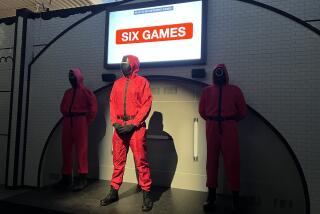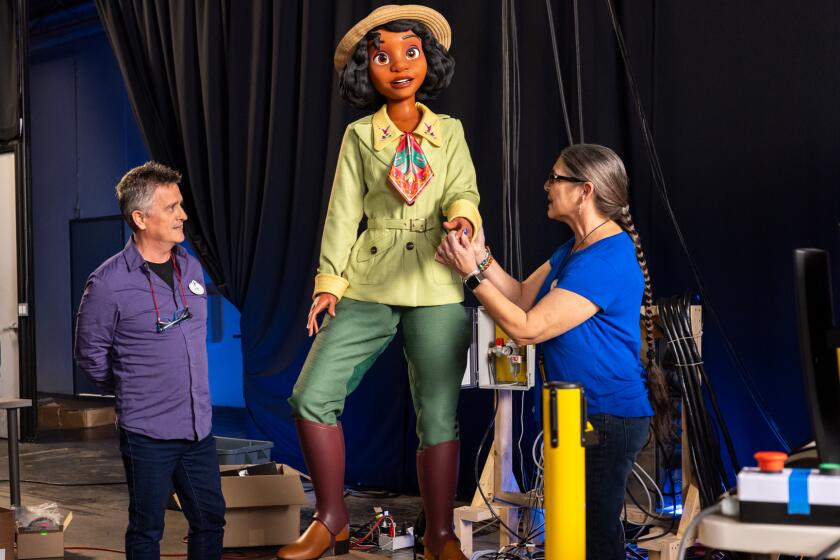The Player: From ‘Walking Dead’ to walking dread: ‘Firewatch’ creators mix heartbreak and the creeps
“Firewatch,” set in the quiet Wyoming wilderness, is a game in which its main character does little more than walk. Yet at its heart this is a game about running.
It’s about running from our pasts, running from our emotional trials and running from the unknown. It’s about how avoidance often makes things worse, and how the road to conquering our fears can be downright frightening.
And things get pretty bad in “Firewatch.”
That is perhaps expected. “Firewatch’s” core developer and writer, Jake Rodkin and Sean Vanaman, worked on the first season of Telltale’s grippingly tense redemption game “The Walking Dead.” Still, “Firewatch,” the first from San Francisco studio Campo Santo, is different. At times it feels like a great American breakup novel. Other times it owes a debt to the psychological horror artfully navigated by the early films of Christopher Nolan.
See the most-read stories in Entertainment this hour >>
Set one year after Yellowstone’s devastating 1988 fires, “Firewatch,” with a not-so-subtle torched-earth backdrop, puts the player-controlled Henry and his mysterious boss Delilah in increasingly weird situations. Maybe teenage girls have disappeared. Maybe someone sabotaged all the phone lines out of Yellowstone. Maybe Henry and Delilah have been framed for a forest fire.
Our heroes, if they are indeed heroes, arrive in Yellowstone to run from their problems. “Firewatch” is about how life eventually catches up.
Though the second hour becomes an anxious mystery, “Firewatch” is a deeply personal game, introducing us in its heartbreaking opening moments to the mind of Henry, a man in his early 40s. In a matter of minutes, Vanaman and Rodkin have dragged us through the course of a relationship, from the meet-cute moment to the arguments over which sort of dog to adopt and then into the near-breakup-inducing blows over which city to live in.
It’s like the beginning of Disney/Pixar film “Up,” Vanaman says, if “Up” had been more realistic; we’re not 10 minutes into “Firewatch” before Henry’s lovely academic wife, Julia, is beset with early on-set dementia and is essentially taken from him.
“The ‘Up’ opening is crushing because it’s a storybook projection of what growing old together is,” says Vanaman, 31. “I didn’t want to do that because that’s not what my life has been like. We were going to give equal time to drinking beer and having fun and loving your partner as we were to arguments and disagreements and challenging life decisions. What if your partner wants this job somewhere else and you’re dreading it? How do you handle that? There’s no good answer, especially if you’re emotionally stubborn.”
Let’s get this out of the way: Vanaman has never had a significant other diagnosed with a life-threatening disease, but a relationship-gone-wrong heavily informs “Firewatch.”
“I went through a very challenging breakup in the middle of production of this game. I was with someone who just had career needs that were all over the world,” he says. “That is definitely from my life.”
That’s key because Henry, a sort of pessimistic yet stubborn, no-nonsense guy from Wyoming — a man who loves his beer and his baseball — doesn’t know how to cope with what’s happening to his wife. He accepts a job in Yellowstone as an outlook, essentially assigned to keep an eye on campers and to help prevent forest fires. He’ll be there for the summer, alone, mostly, with his typewriter. Or so he thinks. It isn’t long before we get the sense that Henry and Delilah are being watched, and the tone of “Firewatch” instantly shifts from sad to creepy.
“I wanted to create a character who I had a lot of empathy for, who was going to try and get through that alone, and then put him with someone else and see what happened,” Vanaman says. “Before the game started, I was in this head space — a really low part of my life. Bad stuff happened. You can’t stop it. Eventually, your parents are going to die. Or somebody is going to get taken away from you in a way that’s just cruel. How do you deal with that? How have billions of people over the history of the planet managed to get through that? It was a big mystery to myself. This game is sort of exploring that.”
“Firewatch” takes its time in the beginning, wanting Henry’s emotional state and that of the player to sort of meld. Much of the game is simply walking around Yellowstone, traversing a cliff or looking for a way around a creek. With a warm, sunset-hued art style from Olly Moss, the game feels inviting even as it starts to spin off the rails.
Sometimes Delilah sends Henry on an errand, and the two chat along the way via walkie-talkie. When Delilah attempts to pry into Julia’s condition, the player, as Henry, can resist, or instead form a bond rather fast with this new friend. Cue drunken walkie-talkie flirting, and maybe you’ll feel a little guilty, or maybe you’ll simply be using it to see if Delilah knows more about Yellowstone’s mysteries than she’s letting on.
Delilah has her own secrets, her own inept relationship history. Others who have landed in Yosemite have struggled at friendships or fatherhood. Henry, as he comes across locked caves and random fences, starts to become haunted by all of them. Is Henry being followed, or is his mind simply playing tricks with him? At numerous times late in “Firewatch,” I found it quite scary, though it never deviated from its core themes.
Vanaman notes that he and Rodkin pitched a psychological thriller game, often leaving all the stuff about personal relationships out of initial conversations. They compared the tone, for instance, to David Fincher’s serial killer film “Zodiac,” playing up the questions about who is stalking Henry and why.
But finding the right investor proved difficult — and not for the usual reasons.
“The struggle of the game is that we were coming off ‘The Walking Dead,’ which is a mega-success, and people wanted to give us too much money,” Vanaman says.” People wanted to give us $20 million and then we’d have no control over the [intellectual property] and they wouldn’t give us final cut. We didn’t want to do that. We wanted to find a way with less money and make something we could control and own and make something that’s personal.”
He explains: “Once you take $20 million, you’re expected to spend that, and the only way to spend that in game development is head count,” he says. “So we would have had to hire 35 people, and if the game didn’t do well — or we didn’t get the next game signed — we’d have to fire 30 people. I don’t have the stomach for that.”
Vanaman won’t reveal the final budget — he says he’s taking it to his grave — but it’s safe to say it’s significantly less than $20 million. App developer Panic Inc., a company headed by longtime friends, took a chance on “Firewatch,” and the Campo Santo team that made the game was closer to 10 than 35.
The resulting game, available now for the PlayStation 4 and home computers, is the oddly haunting and curiously intimate game the team envisioned.
As Henry, players inhabit a character in over his head — emotionally as well as in the strange happenings at Yellowstone. Some players, Vanaman admits, may be turned off by the opening tragedy, but the developer wants as many truthful reactions as possible from players, believing that “the quality of your emotional life is measured upon your ability to react honestly and healthily to the awful things you can’t control.”
“It wasn’t a goal to make a game where you’re powerless, but we were going to make a game where you feel like a person in the real world,” Vanaman says. “It turns out when you strive to let people be real people, real people aren’t very powerful. Is that OK in a game? I think so, sometimes.”
Follow me @toddmartens
‘Firewatch’
Developer and publisher: Campo Santo
Platforms: PlayStation 4, Steam
Price: $19.99
More to Read
The biggest entertainment stories
Get our big stories about Hollywood, film, television, music, arts, culture and more right in your inbox as soon as they publish.
You may occasionally receive promotional content from the Los Angeles Times.







